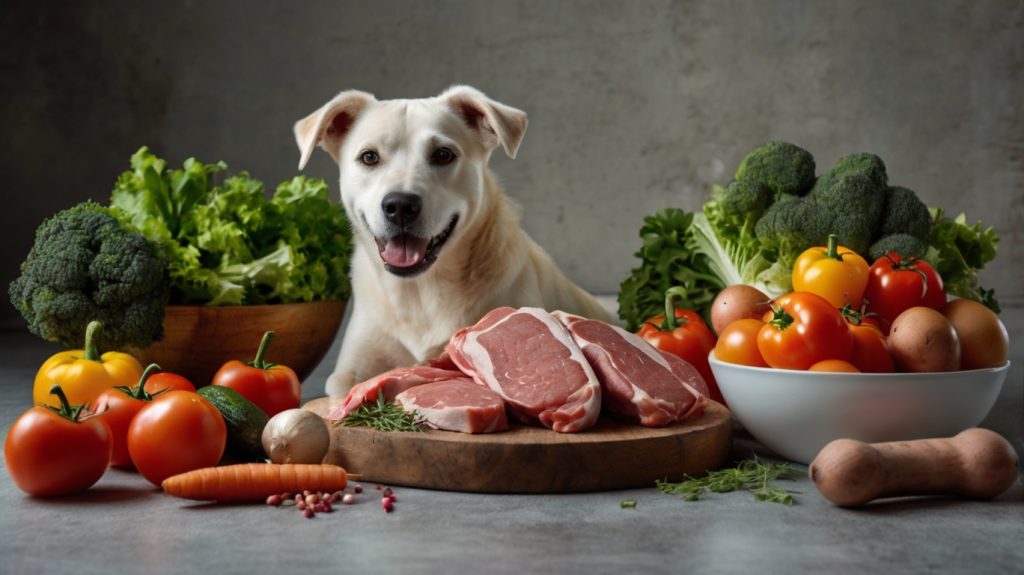The growing interest in raw food diets for dogs reflects pet owners’ desire to provide natural, unprocessed nutrition that mirrors what canines would eat in the wild. While feeding a raw diet can offer significant health benefits, understanding proper implementation is crucial for your dog’s safety and wellbeing.

Understanding Raw Food Diets
A raw dog food diet consists of uncooked ingredients including muscle meat, organ meats, raw bones, fruits, and vegetables. The most popular approaches are the BARF (Biologically Appropriate Raw Food) diet and the Prey Model diet. The BARF diet typically contains 70% muscle meat, 10% raw edible bones, 7% vegetables, 5% liver, 5% other organs, 2% seeds or nuts, and 1% fruit. The Prey Model focuses on 75-80% muscle meat, 10% bones, 5% liver, and 5% other organs.
Health Benefits of Raw Feeding
Dogs following a properly balanced raw diet often experience improved digestion, as raw foods contain natural enzymes that aid nutrient absorption. Many owners report shinier coats, cleaner teeth, increased energy levels, and firmer stools. The absence of processed ingredients and artificial additives can also reduce allergic reactions in sensitive dogs.
Essential nutrients found in raw diets include high-quality proteins for muscle development, healthy fats for coat condition and energy, vitamins and minerals for immune function, and natural enzymes for digestive health. Unlike processed kibble, raw foods retain their nutritional integrity without the need for synthetic supplements.
Safe Implementation Guidelines
When transitioning to raw feeding, start gradually over 7-10 days to allow your dog’s digestive system to adjust. Begin by replacing 25% of their current food with raw, then increase incrementally. Always source muscle meat from reputable suppliers and handle it with the same care you would for human consumption.
Calculate portions based on your dog’s body weight, typically 2-3% for adult dogs. Active dogs or growing puppies may require larger portions, while less active or senior dogs may need smaller amounts. Monitor your dog’s body condition and adjust portions accordingly.
Essential Components and Balance
Muscle meat forms the foundation of any raw diet, providing essential amino acids and protein. Choose variety meats including chicken, beef, lamb, and fish to ensure diverse nutrient profiles. Organ meats, particularly liver, supply concentrated vitamins and minerals that muscle meat lacks.
Raw meaty bones serve multiple purposes: they provide calcium and phosphorus, help clean teeth naturally, and offer mental stimulation. Always feed raw bones appropriate for your dog’s size and supervise consumption. Never feed cooked bones, as they can splinter and cause serious injuries.
Addressing Safety Concerns
Proper food handling eliminates most safety risks associated with raw feeding. Freeze meat for at least 48 hours to eliminate potential parasites, then thaw in the refrigerator. Maintain strict hygiene by washing hands and surfaces thoroughly after handling raw meat.
Small amounts of vegetables can provide additional vitamins, minerals, and fiber. Puree or lightly steam vegetables to aid digestion, as dogs cannot break down plant cell walls as effectively as humans.
Complete and Balanced Nutrition
Creating a nutritionally complete raw diet requires careful planning. Rotate protein sources regularly to ensure varied nutrient intake. Include organ meats weekly, as they contain vital nutrients like vitamin A, B vitamins, and iron that muscle meat lacks.
Consider working with a veterinary nutritionist, especially when starting out. They can help create meal plans that meet all nutritional requirements and adjust portions based on your dog’s individual needs, age, and activity level.
Monitoring Your Dog’s Health
Watch for positive changes such as improved energy, better coat condition, and more consistent stools. Any concerning symptoms like persistent diarrhea, lethargy, or loss of appetite warrant immediate veterinary attention.
Regular health checkups become even more important when feeding raw diets. Blood work can help ensure your dog maintains optimal nutrition levels and organ function.
Cost-Effective Raw Feeding
Raw feeding doesn’t have to be expensive. Build relationships with local butchers who may offer discounts on bulk purchases or less popular cuts. Consider joining raw feeding co-ops to reduce costs through group buying power.
Calculate the true cost by considering your dog’s improved health. Many raw feeders report reduced veterinary bills due to fewer health issues, potentially offsetting the initial higher food costs.
A well-planned raw food diet can provide excellent nutrition for dogs when implemented safely and thoughtfully. Success requires commitment to proper food handling, nutritional balance, and ongoing monitoring. While the transition may seem daunting initially, many pet owners find the health benefits and their dog’s enthusiasm for meals make the effort worthwhile.
Always consult with your veterinarian before making significant dietary changes, especially if your dog has existing health conditions. With proper planning and execution, raw feeding can be a safe and beneficial choice for supporting your dog’s optimal health and vitality.